Central Visayas records more than 100 thousand registered live births in 2018
Central Visayas recorded a total of 136,134 registered live births in the year 2018. This contributes to eight percent of the 1,618,214-total number of registered live births in the country. The region ranked fourth in terms of the highest number of live births recorded. (See Figure 1)
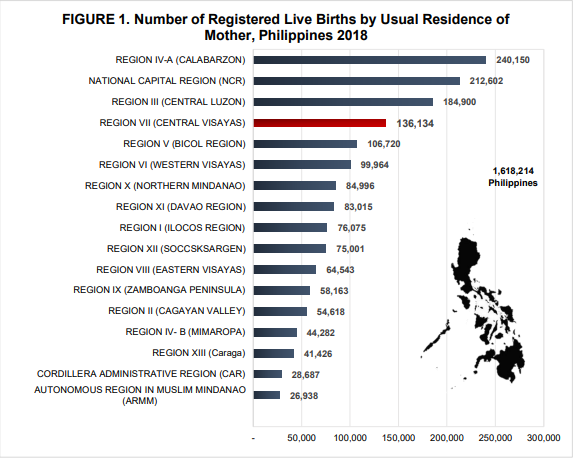
More than 50 percent of the registered live births in Region VII are males
There are 110 males born for every 100 females born in Region 7 in 2018. Registered live births for males totals to 71,465 or 52% while the remaining 48% or 64,669 were females. (See Figures 2 & 3).
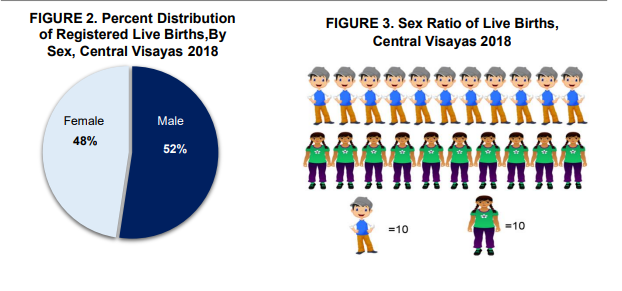
Cebu Province lodges the highest percentage distribution of live births in 2018
The Province of Cebu registered the highest number of live births in the year 2018, with more than 56 thousand or 41 percent of the total live births in the region. Second on the list was Negros Oriental with almost 22 thousand or 16 percent, followed by Bohol with about twenty thousand or 15 percent registered live births. Highly urbanized cities such as Cebu City with almost twenty thousand or 15 percent, Lapu-Lapu with about ten thousand or 7 percent and Mandaue has seven thousand or 5 percent contribution. Meanwhile, Siquijor had the lowest percentage contribution of live births with less than two thousand or one percent. (See Figure 4)
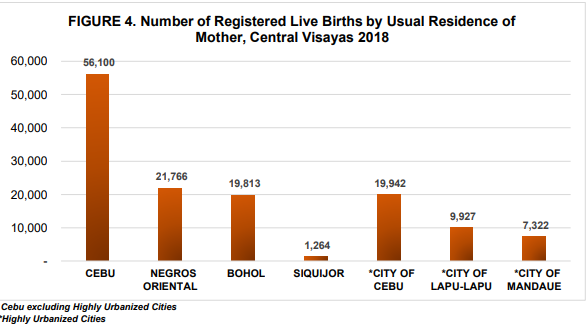
Region VII polls 47 thousand death occurrences in 2018
Central Visayas recorded a total of 47,139 death occurrence in 2018. This gives a percentage share of about eight percent of the 585,314 total number of registered deaths in the country on the same period. The Region ranked fifth with the most number of deaths in the country. (See Figure 5)
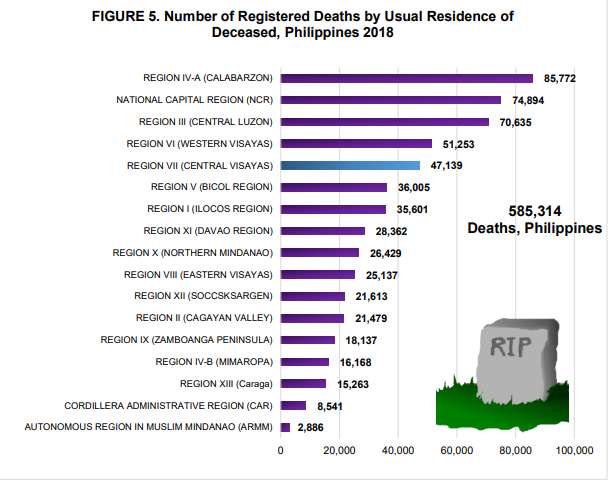
Fifty-five percent or 26,259 of the death occurrences were males while the remaining 45 percent or 20,880 were females. (See Figure 6)
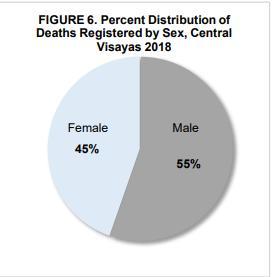
Deaths in Cebu Province is the highest in Region VII
In Central Visayas, 18,592 or 39 percent of the total death statistics in the region were counted in the province of Cebu in the year 2018. This was followed by the province of Bohol with 8, 932 or 20 percent and Negros Oriental with 8, 509 or 18 percent of the region’s total death statistics. Highly urbanized cities namely; Cebu, Lapu-Lapu and Mandaue recorded 6, 477 or 13 percent, 1,994 or 4 percent and 1, 780 or 3 percent, respectively. Meanwhile, the province of Siquijor has the lowest death occurrence of only 855 or 1 percent of the region’s total. (See Figure 7)

More than 36 thousand marriages in Region VII are reported in 2018
Central Visayas accounted a total of 36,402 marriage occurrences in the year 2018. This contributes eight percent of the 445,680 total marriages in the Philippines. Region VII ranked fourth in the highest number of marriage occurrences in the country. (See Figure 8)
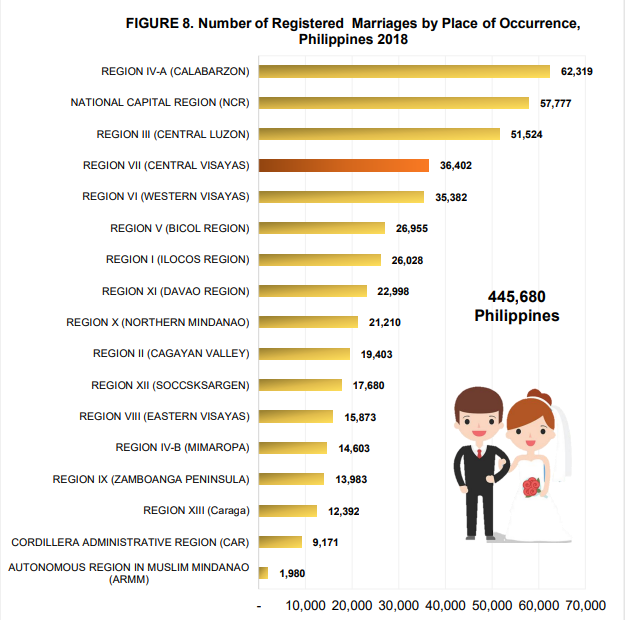
Cebu Province holds the highest number of marriages registered in Central Visayas
The Province of Cebu registered about 15,000 or 40 percent marriages in 2018. This was followed by Negros Oriental with about 7,500 or 20 percent and Bohol with more than 6,500 or 18 percent. Among the highly urbanized cities, Cebu has the highest number of marriages with more than 4,000 or 12 percent, Lapu-Lapu is the second with almost 2,000 or 5 percent and lastly Mandaue with more than 1,000 or 3 percent. Meanwhile, Siquijor had the least marriages of about 400 or one percent of the regional total. (See Figure 9)

Technical Notes:
Vital statistics » are derived from information obtained at the time when the occurrences of vital events and their characteristics are inscribed in a civil register. Vital acts and events are the births, deaths, fetal deaths, marriages, and all such events that have something to do with an individual's entrance and departure from life together with the changes in civil status that may occur to a person during his lifetime.
Live Birth » is the complete expulsion or extraction from its mother of a product of conception, irrespective of the duration of pregnancy, which, after such separation, breathes or shows any other evidence of life.
Marriage » is a special contract of permanent union between a man and a woman entered into in accordance with law for the establishment of conjugal and family life.
Death » refers to the permanent disappearance of all evidence of life at any time after live birth has taken place.
Approved by:
(SGD.) ARIEL E. FLORENDO
Regional Director

